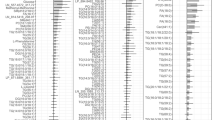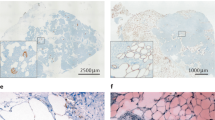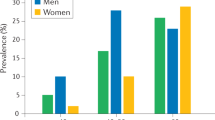Abstract
Objectives:
Recent literature suggests that ectopic fat deposition in the pancreas may contribute to endocrine and exocrine organ dysfunction, such as type 2 diabetes (T2D), pancreatitis or pancreatic cancer. The aim of this study was to determine factors associated with pancreatic triglyceride content (PTGC), and to investigate the impact of bariatric surgery on ectopic fat pads, pancreatic fat (PTGC) and hepatic fat (HTGC).
Subjects:
In all, 45 subjects (13 lean, 13 obese nondiabetics and 19 T2D, matched for age and gender) underwent 1H-magnetic resonance spectroscopy, computed tomography of the visceral abdominal fat, metabolic and lipidomic analysis, including insulin-resistance homeostasis model assessment (HOMA-IR), insulin-secretion homeostasis model assessment (HOMA-B) and plasma fatty-acid composition. Twenty obese subjects were reassessed 6 months after the bariatric surgery.
Results:
PTGC was significantly higher in type 2 diabetic subjects (23.8±3.2%) compared with obese (14.0±3.3; P=0.03) and lean subjects (7.5±0.9%; P=0.0002). PTGC remained significantly associated with T2D after adjusting for age and sex (β=0.47; P=0.004) or even after adjusting for waist circumference, triglycerides and HOMA-IR (β=0.32; P=0.04). T2D, C18:1n-9 (oleic acid), uric acid, triglycerides and plasminogen activator inhibitor-1 were the five more important parameters involved in PTGC prediction (explained 80% of PTGC variance). Bariatric surgery induced a huge reduction of both HTGC (−51.2±7.9%) and PTGC (−43.8±7.0%) reaching lean levels, whereas body mass index remained greatly elevated. An improvement of insulin resistance HOMA-IR and no change in HOMA-B were observed after bariatric surgery. The PTGC or HTGC losses were not correlated, suggesting tissue-specific mobilization of these ectopic fat stores.
Conclusion:
Pancreatic fat increased with T2D and drastically decreased after the bariatric surgery. This suggests that decreased PTGC may contribute to improved beta cell function seen after the bariatric surgery. Further, long-term interventional studies are warranted to examine this hypothesis and to determine the degree to which ectopic fat mobilization may mediate the improvement in endocrine and exocrine pancreatic functions.
This is a preview of subscription content, access via your institution
Access options
Subscribe to this journal
Receive 12 print issues and online access
$259.00 per year
only $21.58 per issue
Buy this article
- Purchase on Springer Link
- Instant access to full article PDF
Prices may be subject to local taxes which are calculated during checkout



Similar content being viewed by others
References
Despres JP . Body fat distribution and risk of cardiovascular disease: an update. Circulation 2012; 126: 1301–1313.
Szendroedi J, Roden M . Ectopic lipids and organ function. Curr Opin Lipidol 2009; 20: 50–56.
van Herpen NA, Schrauwen-Hinderling VB . Lipid accumulation in non-adipose tissue and lipotoxicity. Physiol Behav 2008; 94: 231–241.
Wang MY, Grayburn P, Chen S, Ravazzola M, Orci L, Unger RH . Adipogenic capacity and the susceptibility to type 2 diabetes and metabolic syndrome. Proc Natl Acad Sci USA 2008; 105: 6139–6144.
Hannukainen JC, Borra R, Linderborg K, Kallio H, Kiss J, Lepomaki V et al. Liver and pancreatic fat content and metabolism in healthy monozygotic twins with discordant physical activity. J Hepatol 2011; 54: 545–552.
Heni M, Machann J, Staiger H, Schwenzer NF, Peter A, Schick F et al. Pancreatic fat is negatively associated with insulin secretion in individuals with impaired fasting glucose and/or impaired glucose tolerance: a nuclear magnetic resonance study. Diabetes Metab Res Rev 2010; 26: 200–205.
Saisho Y, Butler AE, Meier JJ, Monchamp T, Allen-Auerbach M, Rizza RA et al. Pancreas volumes in humans from birth to age one hundred taking into account sex, obesity, and presence of type-2 diabetes. Clin Anat 2007; 20: 933–942.
Tushuizen ME, Bunck MC, Pouwels PJ, Bontemps S, van Waesberghe JH, Schindhelm RK et al. Pancreatic fat content and beta-cell function in men with and without type 2 diabetes. Diabetes care 2007; 30: 2916–2921.
van der Zijl NJ, Goossens GH, Moors CC, van Raalte DH, Muskiet MH, Pouwels PJ et al. Ectopic fat storage in the pancreas, liver, and abdominal fat depots: impact on beta-cell function in individuals with impaired glucose metabolism. J Clin Endocrinol Metab 2011; 96: 459–467.
Navina S, Acharya C, DeLany JP, Orlichenko LS, Baty CJ, Shiva SS et al. Lipotoxicity causes multisystem organ failure and exacerbates acute pancreatitis in obesity. Sci Transl Med 2011; 3: 107ra110.
Mathur A, Hernandez J, Shaheen F, Shroff M, Dahal S, Morton C et al. Preoperative computed tomography measurements of pancreatic steatosis and visceral fat: prognostic markers for dissemination and lethality of pancreatic adenocarcinoma. HPB (Oxford) 2011; 13: 404–410.
Pitt HA . Hepato-pancreato-biliary fat: the good, the bad and the ugly. HPB (Oxford) 2007; 9: 92–97.
Smits MM, van Geenen EJ . The clinical significance of pancreatic steatosis. Nat Rev Gastroenterol Hepatol 2011; 8: 169–177.
Rosso E, Casnedi S, Pessaux P, Oussoultzoglou E, Panaro F, Mahfud M et al. The role of "fatty pancreas" and of BMI in the occurrence of pancreatic fistula after pancreaticoduodenectomy. J Gastrointest Surg 2009; 13: 1845–1851.
Yeo TP, Lowenfels AB . Demographics and epidemiology of pancreatic cancer. Cancer J 2012; 18: 477–484.
Lingvay I, Esser V, Legendre JL, Price AL, Wertz KM, Adams-Huet B et al. Noninvasive quantification of pancreatic fat in humans. J Clin Endocrinol Metab 2009; 94: 4070–4076.
Gaborit B, Jacquier A, Kober F, Abdesselam I, Cuisset T, Boullu-Ciocca S et al. Effects of bariatric surgery on cardiac ectopic fat: lesser decrease in epicardial fat compared to visceral fat loss and no change in myocardial triglyceride content. J Am Coll Cardiol 2012; 60: 1381–1389.
Tamura Y, Tanaka Y, Sato F, Choi JB, Watada H, Niwa M et al. Effects of diet and exercise on muscle and liver intracellular lipid contents and insulin sensitivity in type 2 diabetic patients. J Clin Endocrinol Metab 2005; 90: 3191–3196.
Colles SL, Dixon JB, Marks P, Strauss BJ, O'Brien PE . Preoperative weight loss with a very-low-energy diet: quantitation of changes in liver and abdominal fat by serial imaging. Am J Clin Nutr 2006; 84: 304–311.
Lim EL, Hollingsworth KG, Aribisala BS, Chen MJ, Mathers JC, Taylor R . Reversal of type 2 diabetes: normalisation of beta cell function in association with decreased pancreas and liver triacylglycerol. Diabetologia 2011; 54: 2506–2514.
American Diabetes Association. Diagnosis and classification of diabetes mellitus. Diabetes care 2013; 36: S67–S74.
Gaborit B, Kober F, Jacquier A, Moro PJ, Cuisset T, Boullu S et al. Assessment of epicardial fat volume and myocardial triglyceride content in severely obese subjects: relationship to metabolic profile, cardiac function and visceral fat. Int J Obes (Lond) 2012; 36: 422–430.
Jensen MD, Kanaley JA, Reed JE, Sheedy PF . Measurement of abdominal and visceral fat with computed tomography and dual-energy x-ray absorptiometry. Am J Clin Nutr 1995; 61: 274–278.
Du Q, Martin JC, Agnani G, Pages N, Leruyet P, Carayon P et al. Dairy fat blends high in alpha-linolenic acid are superior to n-3 fatty-acid-enriched palm oil blends for increasing DHA levels in the brains of young rats. J Nutr Biochem 2012; 23: 1573–1582.
Trygg J, Holmes E, Lundstedt T . Chemometrics in metabonomics. J Proteome Res 2007; 6: 469–479.
Cramer RD . Partial Least Squares (PLS): its strengths and limitations. Perspect Drug Discov 1993; 1: 269–278.
Eriksson KJE, Kettaneh-Wold N, Wikström C, Wold S . Multi- and megavariate analysis. Part I: Basic principles and applications. PLos One 2006; 7: 1–419.
Chavance M . [Jackknife and bootstrap]. Revue d'epidemiologie et de sante publique 1992; 40: 209–218.
Pinnick KE, Collins SC, Londos C, Gauguier D, Clark A, Fielding BA . Pancreatic ectopic fat is characterized by adipocyte infiltration and altered lipid composition. Obesity (Silver Spring) 2008; 16: 522–530.
Lee Y, Lingvay I, Szczepaniak LS, Ravazzola M, Orci L, Unger RH . Pancreatic steatosis: harbinger of type 2 diabetes in obese rodents. Int J Obes (Lond) 2010; 34: 396–400.
Mathur A, Marine M, Lu D, Swartz-Basile DA, Saxena R, Zyromski NJ et al. Nonalcoholic fatty pancreas disease. HPB (Oxford) 2007; 9: 312–318.
Patel AV, Rodriguez C, Bernstein L, Chao A, Thun MJ, Calle EE . Obesity, recreational physical activity, and risk of pancreatic cancer in a large U.S. Cohort. Cancer Epidemiol Biomarkers Prev 2005; 14: 459–466.
Tranchart H, Gaujoux S, Rebours V, Vullierme MP, Dokmak S, Levy P et al. Preoperative CT scan helps to predict the occurrence of severe pancreatic fistula after pancreaticoduodenectomy. Ann Surg 2012; 256: 139–145.
Sadr-Azodi O, Orsini N, Andren-Sandberg A, Wolk A . Abdominal and total adiposity and the risk of acute pancreatitis: a population-based prospective cohort study. Am J Gastroenterol 2013; 108: 133–139.
Petrov MS . Editorial: abdominal fat: a key player in metabolic acute pancreatitis. Am J Gastroenterol 2013; 108: 140–142.
Rossi AP, Fantin F, Zamboni GA, Mazzali G, Rinaldi CA, Del Giglio M et al. Predictors of ectopic fat accumulation in liver and pancreas in obese men and women. Obesity (Silver Spring) 2011; 19: 1747–1754.
van Raalte DH, van der Zijl NJ, Diamant M . Pancreatic steatosis in humans: cause or marker of lipotoxicity?. Curr Opin Clin Nutr Metab Care 2010; 13: 478–485.
Wong VW, Wong GL, Yeung DK, Abrigo JM, Kong AP, Chan RS et al. Fatty pancreas, insulin resistance, and beta-cell function: a population study using fat-water magnetic resonance imaging. Am J Gastroenterol 2014; 109: 589–597.
Szczepaniak LS, Victor RG, Mathur R, Nelson MD, Szczepaniak EW, Tyer N et al. Pancreatic steatosis and its relationship to beta-cell dysfunction in humans: racial and ethnic variations. Diabetes care 2012; 35: 2377–2383.
Ryu S, Chang Y, Kim SG, Cho J, Guallar E . Serum uric acid levels predict incident nonalcoholic fatty liver disease in healthy Korean men. Metabolism 2011; 60: 860–866.
Lonardo A, Loria P, Leonardi F, Borsatti A, Neri P, Pulvirenti M et al. Fasting insulin and uric acid levels but not indices of iron metabolism are independent predictors of non-alcoholic fatty liver disease. A case-control study. Dig Liver Dis 2002; 34: 204–211.
Roncal-Jimenez CA, Lanaspa MA, Rivard CJ, Nakagawa T, Sanchez-Lozada LG, Jalal D et al. Sucrose induces fatty liver and pancreatic inflammation in male breeder rats independent of excess energy intake. Metabolism 2011; 60: 1259–1270.
Gotoh K, Inoue M, Shiraishi K, Masaki T, Chiba S, Mitsutomi K et al. Spleen-derived interleukin-10 downregulates the severity of high-fat diet-induced non-alcoholic fatty pancreas disease. PLoS One 2012; 7: e53154.
Nannipieri M, Baldi S, Mari A, Colligiani D, Guarino D, Camastra S et al. Roux-en-Y gastric bypass and sleeve gastrectomy: mechanisms of diabetes remission and role of gut hormones. J Clin Endocrinol Metab 2013; 98: 4391–4399.
Jackness C, Karmally W, Febres G, Conwell IM, Ahmed L, Bessler M et al. Very low-calorie diet mimics the early beneficial effect of Roux-en-Y gastric bypass on insulin sensitivity and beta-cell Function in type 2 diabetic patients. Diabetes 2013; 62: 3027–3032.
Snel M, Jonker JT, Schoones J, Lamb H, de Roos A, Pijl H et al. Ectopic fat and insulin resistance: pathophysiology and effect of diet and lifestyle interventions. Internatl J Endocrinol 2012; 2012: 983814.
Khalaf KI, Taegtmeyer H . Slimming the heart with bariatric surgery. J Am Coll Cardiol 2013; 61: 990–991.
Adams TD, Hunt SC . Cancer and obesity: effect of bariatric surgery. World J Surg 2009; 33: 2028–2033.
Sjostrom L, Gummesson A, Sjostrom CD, Narbro K, Peltonen M, Wedel H et al. Effects of bariatric surgery on cancer incidence in obese patients in Sweden (Swedish Obese Subjects Study): a prospective, controlled intervention trial. Lancet Oncol 2009; 10: 653–662.
Acknowledgements
We thank Gabrielle Belpassi, Valérie Griset, Sylvie Bourrely and Aurelia Mesnier, of the Centre d’Investigation Clinique at Marseille North Hospital, for their help in choosing patients for inclusion and for their biological technical assessment. We thank Patricia Ancel, Virginie Tassistro and Jacques Boukhalil for their technical help. We thank the nurses and all the staff of the endocrinology and digestive surgery department for their invaluable support.
Author information
Authors and Affiliations
Corresponding author
Ethics declarations
Competing interests
The authors declare no conflict of interest.
Additional information
Supplementary Information accompanies this paper on International Journal of Obesity website
Rights and permissions
About this article
Cite this article
Gaborit, B., Abdesselam, I., Kober, F. et al. Ectopic fat storage in the pancreas using 1H-MRS: importance of diabetic status and modulation with bariatric surgery-induced weight loss. Int J Obes 39, 480–487 (2015). https://doi.org/10.1038/ijo.2014.126
Received:
Revised:
Accepted:
Published:
Issue Date:
DOI: https://doi.org/10.1038/ijo.2014.126
This article is cited by
-
Combined effect of pancreatic lipid content and gene variants (TCF7L2, WFS1 and 11BHSD1) on B-cell function in Middle Aged Women in a Post Hoc Analysis
Diabetology & Metabolic Syndrome (2022)
-
Metabolic implications of pancreatic fat accumulation
Nature Reviews Endocrinology (2022)
-
Intra-pancreatic fat deposition: bringing hidden fat to the fore
Nature Reviews Gastroenterology & Hepatology (2022)
-
Imaging evaluation of the pancreas in diabetic patients
Abdominal Radiology (2022)
-
Use of Magnetic Resonance Imaging to Quantify Fat and Steatosis in the Pancreas in Patients after Bariatric Surgery: a Retrospective Study
Obesity Surgery (2022)



